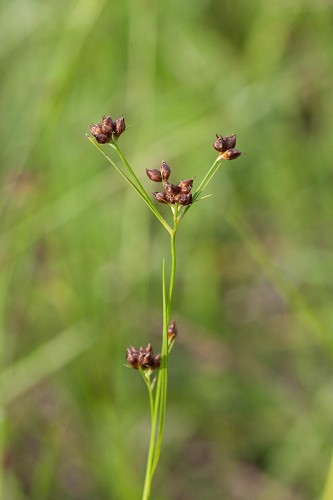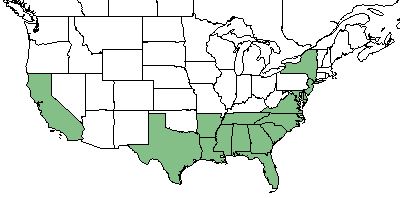Difference between revisions of "Rhynchospora globularis"
(→Conservation and Management) |
(→Ecology) |
||
| Line 30: | Line 30: | ||
==Ecology== | ==Ecology== | ||
| − | ===Habitat=== <!--Natural communities, human disturbed habitats, topography, hydrology, soils, light, fire regime requirements for removal of competition, etc.--> | + | ===Habitat=== |
| + | Sandy depressions, wet ditches, powerline corridors, and savannas are common habitats for ''R. globulairs''.<ref name= "Weakley"> Weakley, A. S. (2015). Flora of the Southern and Mid-Atlantic States. Chapel Hill, NC, University of North Carolina Herbarium.</ref> | ||
| + | <!--Natural communities, human disturbed habitats, topography, hydrology, soils, light, fire regime requirements for removal of competition, etc.--> | ||
<!--===Phenology===--> <!--Timing off flowering, fruiting, seed dispersal, and environmental triggers. Cite PanFlora website if appropriate: http://www.gilnelson.com/PanFlora/ --> | <!--===Phenology===--> <!--Timing off flowering, fruiting, seed dispersal, and environmental triggers. Cite PanFlora website if appropriate: http://www.gilnelson.com/PanFlora/ --> | ||
<!--===Seed dispersal===--> | <!--===Seed dispersal===--> | ||
Revision as of 12:56, 29 May 2018
| Rhynchospora globularis | |
|---|---|

| |
| Photo by John Gwaltney hosted at Southeastern Flora.com | |
| Scientific classification | |
| Kingdom: | Plantae |
| Division: | Magnoliophyta - Flowering plants |
| Class: | Liliopsida – Monocotyledons |
| Order: | Poales |
| Family: | Cyperaceae |
| Genus: | Rhynchospora |
| Species: | R. globularis |
| Binomial name | |
| Rhynchospora globularis Chapm. Small | |

| |
| Natural range of Rhynchospora globularis from USDA NRCS Plants Database. | |
Contents
Taxonomic Notes
Synonym: none
Variety: none
Description
R. globularis is a annual/perennial graminoid of the Cyperaceae family that is native to North America.[1]
Distribution
Found largely throughout the southeastern United States, R. globularis is specifically in Florida, Georgia, South Carolina, North Carolina, Virginia, Maryland, New Jersey, New York, Tennessee, Alabama, Mississippi, Louisiana, Texas, Arkansas, as well as in the western state California. [1]
Ecology
Habitat
Sandy depressions, wet ditches, powerline corridors, and savannas are common habitats for R. globulairs.[2]
Conservation and Management
R. globularis is classified as endangered in Maryland, Michigan, New Jersey, Ohio, and is of special concern in Kentucky. [1]
Cultivation and restoration
Photo Gallery
References and notes
- ↑ 1.0 1.1 1.2 USDA Plant Database
- ↑ Weakley, A. S. (2015). Flora of the Southern and Mid-Atlantic States. Chapel Hill, NC, University of North Carolina Herbarium.